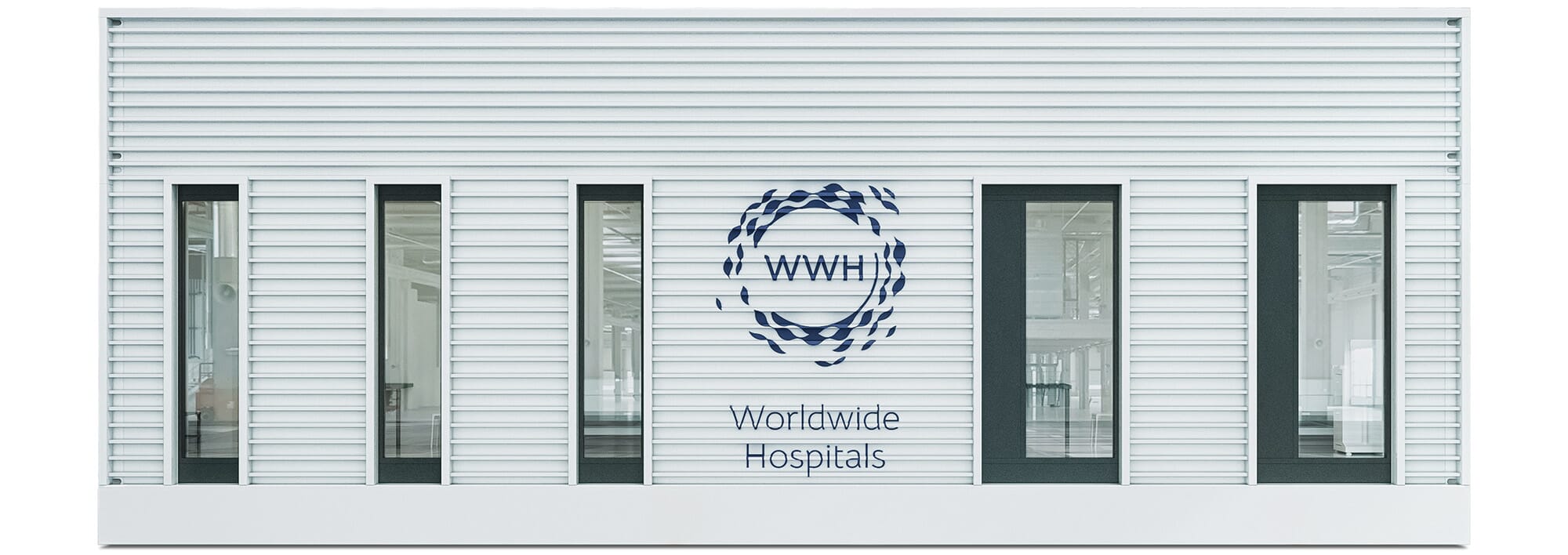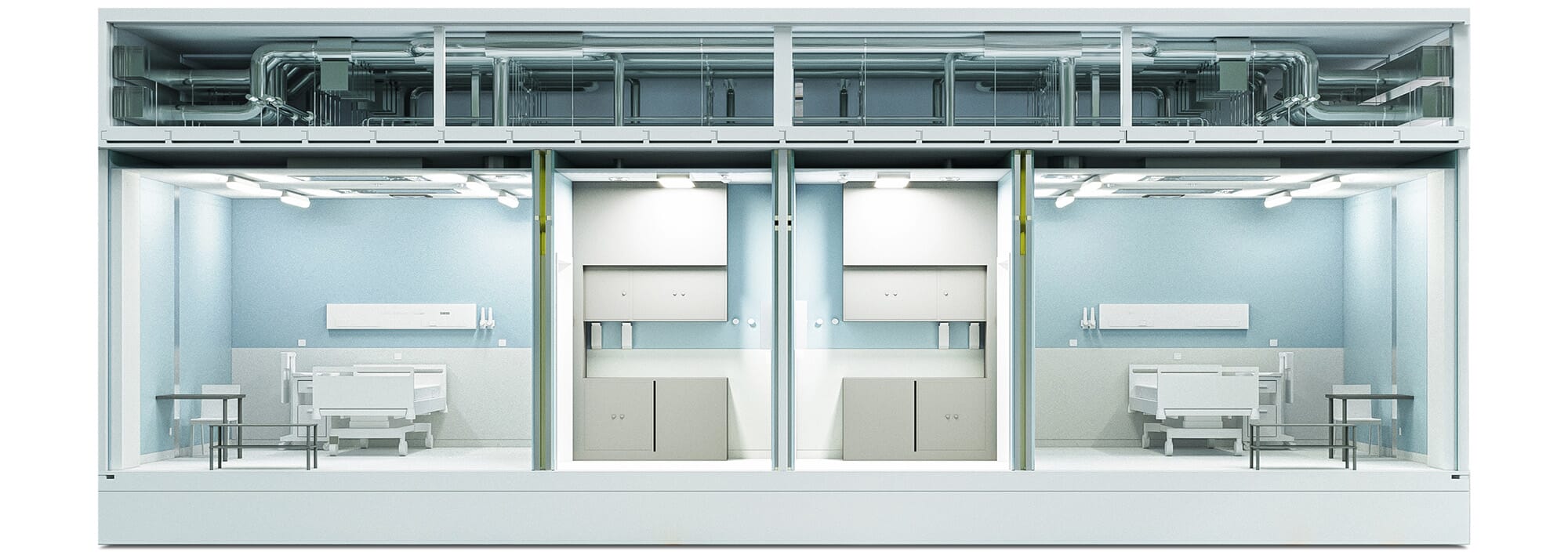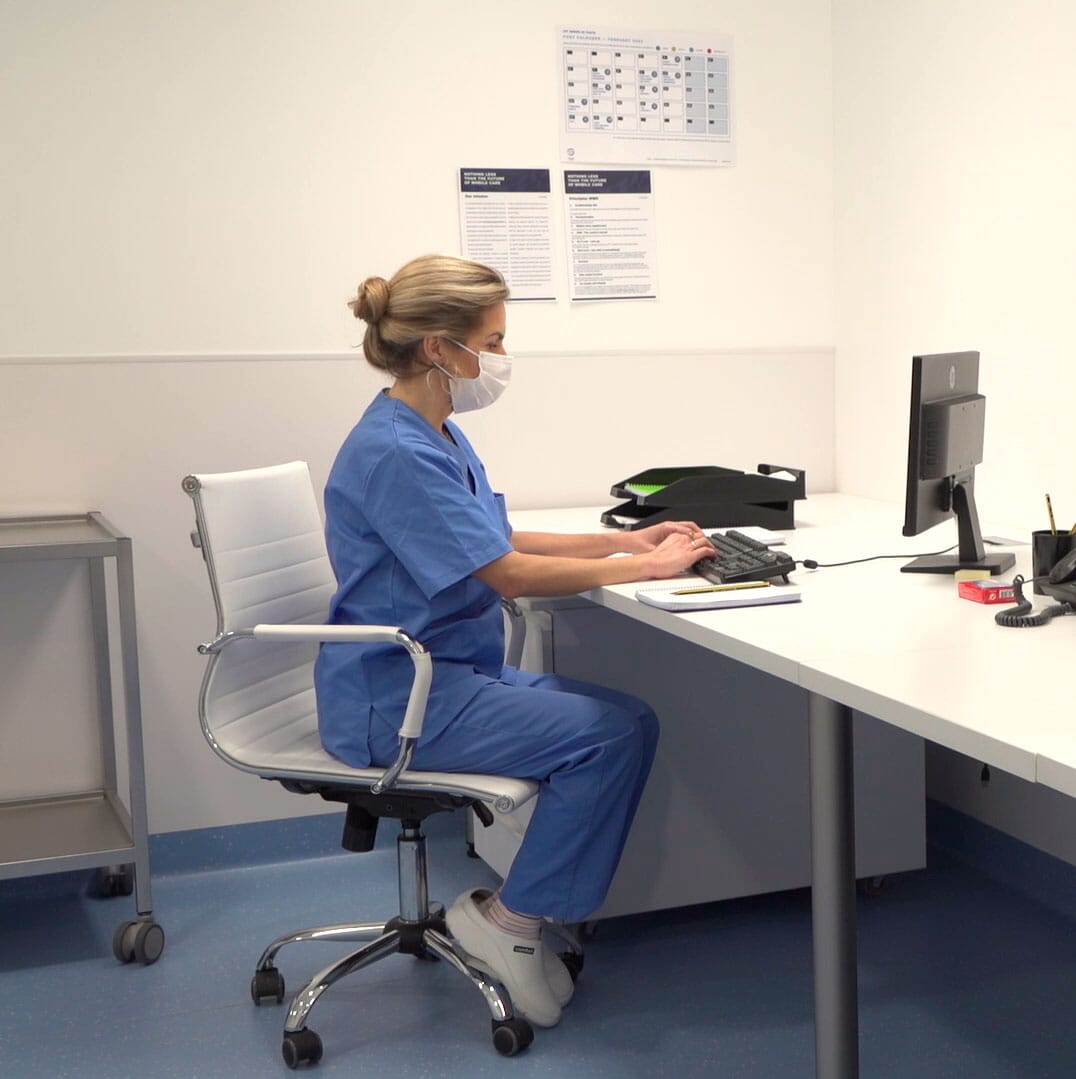The future of
modular hospitals
Our mission as a global healthcare company is to provide flexible modular hospital solutions at the highest medical standard, wherever and whenever needed in the world.
Healthcare for all: We aspire to a world where barriers of location, infrastructure, capacity, and response time no longer mean obstacles to accessing qualified healthcare for every person, family, and community.
Team work: We work together with governments, international organizations, NGOs, and private charities to achieve that mission.
Modular hospitals
Using our Very High-Cube Heavy Duty (VHCHD) & High-Cube Heavy Duty (HCHD) Medical Modules as building blocks to form hospitals on ships or land.
Customized services
Our services are tailored to the client’s requirements: in case of emergency or as long-term solutions.
All-in-One
Our holistic offers include project consulting, healthcare system design, transportation, implementation, operation, maintenance, storage, and trainings.
Our medical modules


3D Rendering of an Equipped 30 m² / 300 ft² Very High-Cube Heavy Duty (VHCHD) Medical Module
Durable
With a lifespan of 30 years, our high-quality Medical Modules are durable and allow adaptability for future changes, minimizing replacement waste and reconstruction.
Weather resistant
Our Medical Modules are built to withstand various weather conditions. They are resistant to moisture, extreme temperatures, sunlight, and other environmental factors.
Fully-Equipped
Our Medical Modules are fully-equipped with compliant ventilation and cooling systems and can include advanced medical equipments X-Ray, Ultrasound and CT scans.
Customizable
Optional integration of solar panels, eco-friendly platforms, rainwater collector, ballistic protection, variable roof options, different facades, and much more.
Sustainable
Using our Medical Modules as building blocks instead of the traditional building process reduces CO₂ emissions due to the absence of cement during construction.
Aseptic
Our Medical Modules provide a safe and controlled environment for performing critical procedures and contributing to the overall success of medical systems.
Our medical Solutions
01 Land-based Hospitals
Transported via trucks or vessels to the land destination, VHCHD Medical Modules quickly set up WWH Land-based Hospitals using our distinctive Click-and-Connect Systems.
Expandable: vertically up to 4 levels and horizontally on all four sides, enabling the creation of healthcare facilities customized to the client's desired size.
Adaptable: to all on-site and climate circumstances and can be effortlessly relocated once their initial mission is accomplished.
Cost-competitive: saving production and assembly costs because our hospitals can be set up in a fraction of the time required for traditional construction.
02 Modular Hospital Ships
With HCHD Medical Modules, we turn the WWH vessels into fully-fledged Hospital Ships, which serve as an afloat and flexible platform that delivers advanced medical care and support where traditional medical facilities are lacking in case of an emergency.
Spacious: with an impressive 9,300 m² / 100,105 ft² of hospital space across seven floors, offering a generous environment with quality.
Quick-response: within just 72 hours, the hospital ship is fully assembled and ready to reach their missions worldwide.
Autonomous: can operate autonomously for over 60+ days without refueling, playing a vital role in humanitarian missions, epidemic outbreaks, refugee crises, and other critical situations.
03 Service Options
Medical, technical, and administrative services from full-service hospital operations to infrastructure maintenance only – whatever the customer requires.
Medical Professionals: sourcing of Medical Staff such as doctors, nurses and technicias worldwide.
Training and mentoring: General Training of Staff and Targeted Training on specific topics.
Hospital Operation and Logistics: we offer Operations Consulting, Hospital Management, Information Technology (IT) Support, Facility Maintenance, Transportation, Logistics, and Storage.
Advantages of WWH Ships
Click on the hotspots of our ships' model to discover more insights
General Hospital Ship Configuration
Hospital space: 9.300 m²/100.105 sq. ft
111 Inpatient Beds
(including 12 specialized ICU beds)
3 Operating Rooms
(one located in the Delivery Ward with Neonatal Resuscitation)
32 Outpatient Examination Rooms
(including specialized rooms for Dental, Ophthalmology and ENT)
Radiology Suite
(with Digital X-ray, CT Scan and Ultrasound)
Dialysis Unit
Negative-pressure Isolation
Click to see each deck plan
Outpatient and Emergency visits
Inpatient Admissions
Surgical procedures
Fast
Prefabricated in Europe, transportation-ready for land and sea, quick to assemble.
Flexible
Expandable in height and area; deployable in all circumstances; easy to operate and relocate.
Fit for Purpose
Customized to clients’ needs; adaptable to emergency, temporary, and long-term requirements.
Production Facilities
Innovation Center
We produce our VHCHD & HCHD Medical Modules according to the highest medical standards. Strategically located, our facility serves also as an innovation center for exhibitions.
Factory in Spain: located in Seville, we provide 200+ jobs by building our VHCHD & HCHD Medical Modules.
We explore technologies to easily adapt to the specific needs of each project.
Our factory Cameleon Modules S.L. is assembling up to 600 VHCHD & HCHD Medical Modules per year to pave the way for mass production, ensuring that our Manufacturing Complex can efficiently create these Medical Modules.
Manufacturing Complex
Strategically located nearby our Headquarters South, our manufacturing center will offer up to 600+ jobs, leaving an impact on the local economy.
Factory in Serbia: Our 39.000 m² facility is currently under construction and will be completed by the end of 2023
It will have capacity for > 6.000 fully equipped and ready for use VHCHD & HCHD Medical Modules p.a.
people die yearly from lack of essential care due to local capacity shortage
worldwide deaths due to a number of clinical conditions
people die yearly from man-made disasters
people worldwide do not have access to emergency and essential surgical care
Global challenges
Africa’s healthcare system is structurally weak with estimated spending of 2.3% of its GDP for health-related services and a life expectancy of only 63 years in some countries.
The hospital bed capacity is low (approx. 8 hospital beds per 10.000 inhabitants) and more importantly, many countries lack access to essential hospital care for large shares of their population.
Around 29% of people must travel more than one hour to access a health facility. In 2020, the World Bank stated that existing hospitals and the health system could not adequately respond to people’s daily health care needs.
Challenges:
- Poor healthcare infrastructure
- Vulnerable parts of society are hit hardest
- Destroyed healthcare infrastructure in some countries
- Existing healthcare infrastructure with limited water/electricity supply
Indonesia sits on a Volcano belt which causes 90% of earthquakes globally. In September 2018, a disastrous earthquake and tsunami hit the island Sulawesi near the city of Palu.
More than 4,000 people lost their lives, 14,000 people were injured, many of them severely. Regional hospitals were overwhelmed. The entire region suffered from a lack of clean water, food, and electricity which further deteriorated public health.
Only a month later, the monsoon season started which further aggrieved the people who had not yet recovered from the disaster. Even months after the disaster, the Red Cross stated that especially children, pregnant women, and elderly people suffered from poor health and inadequate healthcare.
This further puts strain on the already underdeveloped healthcare infrastructure in Indonesia. Government investment in the health system has been limited, leading to insufficient facilities and the workforce needed for public services.
Challenges:
- Poor healthcare infrastructure
- Break down of infrastructure
- Focus on more pressing matters
- Long-term health problems due to poor sanitation
On August 4, 2020, Lebanese capital Beirut was shocked by a massive explosion that had a catastrophic impact on the entire city.
The disastrous blast destroyed large areas of the port and caused damage to vast parts the city’s structure. At least 190 people were killed and more than 6,500 injured. The effects of the explosion were even more devastating in the aftermath, as Beirut’s hospital infrastructure, which had already been overly burdened with COVID-19 cases, broke down.
Three hospitals were evacuated as severely damaged or destroyed. According to the WHO, more than half of the 55 hospitals and health centers in the city were non-functional. With still operating hospitals overloaded and pandemic lockdown suspended.
During the first wave of the COVID-19 pandemic in 2020 Europe suffered many deaths due to an overburden of the existing healthcare infrastructure.
Many cities lacked ICUs and ventilators to treat the new disease.
Hospitals were overwhelmed by the increased influx of patients and triage was applied in some cases to deal with limited capacity.
Challenges:
- Break down of infrastructure
- Lack of equipment
- Lack of medical staff
Video resources
Let's get in touch
Together we can change the future of healthcare worldwide.








